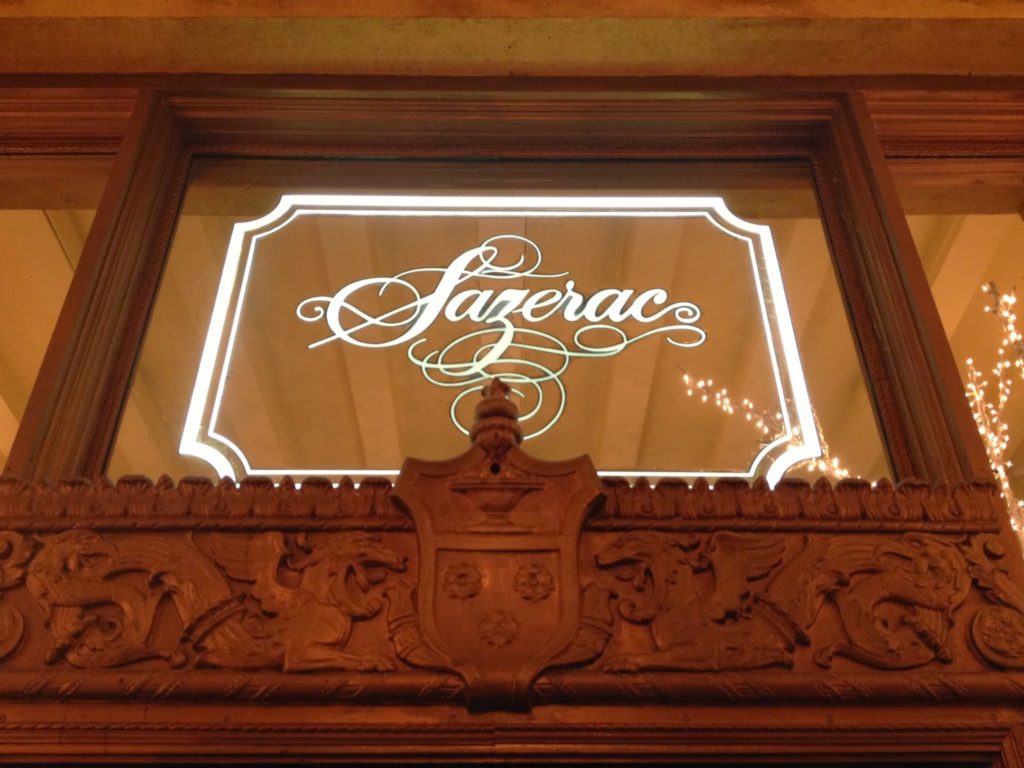For my current favorite Sazerac recipe and an updated history, check out this post!
The Sazerac is a classic New Orleans cocktail. It’s reminiscent of an Old Fashioned, but the addition of anise-flavored liqueur gives it extra depth. It was originally made with absinthe and Sazerac-de-Forge et Fils cognac, which gave the drink its name. Cognac became hard to come by during the grape blight in France in the late 19th century, so at some point it was replaced by rye. Absinthe was banned in the United States in 1912, so this ingredient was also replaced with other anise-flavored liqueurs. When Herbsaint began production in New Orleans in 1934, it became the common ingredient. I make my Sazeracs with rye and Herbsaint, and I’m pretty happy with the result.
History: I thought I was pretty clear about the history of the Sazerac, and the version I knew went something like this: Sewell T. Taylor, the proprietor of the Merchants Exchange Coffee House in New Orleans, sold his establishment to a fellow named Aaron Bird and began importing liquor. One of the popular liquors he imported was the aforementioned Sazerac-de-Forge et Fils cognac, after which Bird decided to rename the Coffee House. He invented the Sazerac there sometime before 1870. Even David Wondrich supported this account. But it turns out that the history of the Sazerac is so convoluted that even he was fooled at first. For an incredibly in-depth account of this twisting and muddled history, check out this piece by Robert F. Moss. For those who are ready to stop reading and get drinking, I’ll do my best to summarize.
Sewell T. Taylor, who supposedly sold his shop to Aaron Bird, does have a connection to a Merchant’s Exchange Coffee House (there were at least three in New Orleans during the time period in question). He managed the Exchange’s liquor. Around 1850, he opened his own shop across the street that imported and sold liquor – including Sazerac-de-Forge et Fils cognac, which was already popular in the city. It was this establishment, not a Coffee House, that Aaron Bird took over when Taylor died, but only for the three years before he also died. But neither one of them appears to have developed the cocktail recipe in question.
The real source of the Sazerac is probably back at the Merchant’s Exchange, which did change its name to the Sazerac Coffee House in the late 1850’s. It was a large establishment, which leads to further confusion as to its address; it took up 14-16 Royal Street and 11-13 Exchange Place. It certainly served Sazerac cognac, probably as a cocktail with sugar and Peychaud’s bitters. All we’re missing is the absinthe.
Thomas H. Handy, who once worked as a clerk at Sewell’s importing business, took over the Sazerac Coffee House in 1871. By 1878, he was so badly in debt that he sold the business to Vincent Micas, who also bought out Peychaud’s. Micas and Handy became rivals when Handy started his own liquor import business and his own line of bitters. Handy still owned the building that contained the Sazerac Coffee House, and in 1882 Micas moved the establishment (now called the Sazerac Barroom) to Camp Street, and Handy demolished the building and built his own Sazerac House on the same site.
It was at Handy’s Sazerac House that the Sazerac cocktail as we know it was born. The earliest written record of it being served appears to be at what was essentially a frat party, the 16th biennial conference of Alpha Tau Omega in 1898. By this point, Handy had died and his business had been taken over by his investor William McQuoid. The first written recipe appears in William T. Boothby’s The World’s Drinks and How to Mix Them in 1908. It calls for cognac, not rye, and Seiner bitters rather than Peychaud’s, Handy’s, or any others. (Incidentally, see Moss’s article for the story of the nasty lawsuit between Handy and Anthony Commander of Commander’s Palace fame over the design of their bitters labels).
 |
| The entrance to the Sazerac Bar in the Roosevelt Hotel, New Orleans |
One place that was not even remotely involved in the creation of the Sazerac is the Sazerac Bar at the Roosevelt Hotel, though it certainly has a colorful history of its own. I visited it for the first time this past December, and was entranced by the gorgeous classic New Orleans atmosphere and the theatrics of the white-suited bartenders. While you can get an excellent Sazerac at the Roosevelt (made with either rye or cognac), the bar purchased the rights to the use the name from the Sazerac company (the same company once owned by Handy, as far as I know) in the 1940’s and relocated to what was the Roosevelt’s Main Bar in 1959. The Main Bar had been a favorite haunt of Huey P. Long, who would order the Ramos Gin Fizz.
And that is the true story of the Sazerac. A bit less romantic, a bit more vague, but probably far more accurate. And still a great piece of New Orleans history.
Sazerac
2 oz. rye
1 sugar cube
2 dashes Peychaud’s bitters
1 dash Angostura bitters
Herbsaint rinse
Lighty moisten the sugar cube and place at the bottom of a rocks glass. Crush with a muddler. (If you don’t have sugar cubes, use 3/4 tsp. sugar.) Add rye and bitters, then fill with ice. Stir. Pour a dash of Herbsaint into a second glass and swirl to coat the sides, or spritz the glass with Herbsaint using a small spray bottle. Strain the cocktail into this glass. Garnish with a lemon twist.
Recipe adapted from Esquire.






